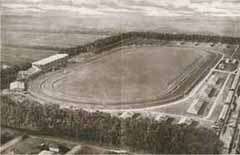Tanforan Racetrack
|
Tanforan Racetrack | |
| Location |
San Bruno, California, United States |
|---|---|
| Date opened | September 4, 1899 |
| Date closed | July 31, 1964 (fire) |
| Course type | Flat for Thoroughbreds |
| Notable races | Tanforan Handicap |
Tanforan Racetrack was a thoroughbred horse racing facility in San Bruno, on the San Francisco Peninsula, in California. It was in operation from September 4, 1899 to 1964. The horse racing track and buildings were constructed to serve a clientele from nearby San Francisco.
The racetrack was destroyed by fire on July 31, 1964.[1] The site is now the location of The Shops at Tanforan shopping center. The mall has a Tanforan Racetrack historical plaque, the Tanforan Assembly Center commemorative garden, and a statue of Seabiscuit.
History
The facility was named after Toribio Tanforan, the grandson-in-law of Jose Antonio Sanchez, the grantee of the Rancho Buri Buri Mexican land grant. [2] [3]
In addition to horse racing, dog, motorcycle, and auto [4] races were also held at the track during its early years. On January 25-26, 1910, the Tanforan Racetrack served as the site for the Second International Air Meet in America, organized by the Pacific Aero Club and attended by aviation notables Louis Paulhan and John J. Montgomery.
On January 18, 1911, Eugene Burton Ely took off from Tanforan in his Curtiss Model D airplane, and landed on the USS_Pennsylvania_(ACR-4) armored cruiser anchored in the San Francisco Bay. [5] This was the first ever successful shipboard landing of an aircraft, and the first to use the tailhook system, leading to today's aircraft carrier technology.
Closed following California's 1911 anti-gambling legislation, it reopened without betting for the 1923 and 1924 seasons through the subsidy of prominent area businessmen led by sugar magnate Adolph B. Spreckels. After 1924, it would be another ten years before a full racing season was held once the ban on parimutuel betting had been lifted. [6]
Hollywood film director Frank Capra filmed scenes for two of his films, Broadway Bill and Riding High, at the racetrack.[7]
World War I

Tanforan was temporarily converted into a United States military training center during World War I. Camp Tanforan was used by the "Grizzlies" which was a regiment of the 144th Field Artillery of the U.S. Army.[8]
Tanforan Assembly Center

In Spring 1942 the Tanforan Park Racetrack became the temporary Tanforan Assembly Center to process approximately 8,000 Bay Area Japanese Americans, U.S. citizens of Japanese ancestry with most born in the United States, for forced relocation and internment during WW II. The people were housed in horse stable stalls, on grandstands, or in 170 barracks quickly built in the infield, while awaiting removal to Japanese American Segregation Centers in other parts of the state and country.[9]
Kazue Togasaki was detained for a month at the Tanforan Assembly Center, and while there she delivered fifty babies and led an all-Japanese-American medical team.[10][11] Artist Miné Okubo was detained at Tanforan before transferring to the Topaz Relocation Center, she documented the daily life in internment camps with a series of drawings, many which were later published in her book "Citizen 13660".[12]
Famous race competitors
Some of thoroughbred racing's most notable owners and trainers competed at Tanforan Racetrack including: owner/breeder James Ben Ali Haggin; owner/trainer Sam Hildreth; and trainer Noble Threewitt. Threewitt set a record when he won with nine consecutive starters at Tanforan in April 1954.[13]
In 1932, the great Australian champion Phar Lap was brought to Tanforan to rest from his long ocean voyage and then conditioned before being shipped in late January to Agua Caliente Racetrack in Tijuana, Mexico to run in the Agua Caliente Handicap.[14]
Over the years, Tanforan Racecourse saw a number of famous horses compete on its track. Among them, future U.S. Racing Hall of Fame inductee Seabiscuit was stabled at Tanforan after recovering from an injury where he began training for a comeback.[15]
In 1948, future U. S. Racing Hall of Fame inductee Citation set a new Tanforan track record of 2:02 4/5 for a mile and one quarter in winning the Tanforan Handicap.[16] Two years later his Calumet Farm stablemate and Kentucky Derby winner, Ponder, also won the race. [17]
In 1956, Bobby Brocato won his second straight Tanforan Handicap. That same year, he equaled the Tanforan track record for 8.5 furlongs and set a new track for 9 furlongs.[18]
References
| Wikimedia Commons has media related to Tanforan Assembly Center. |
- ↑ Image of the ruins of Tanforan Racetrack following the 1964 fire
- ↑ City of San Bruno, California website with information on Tanforan Racetrack
- ↑ Calisphere (University of California) – master list of 147 images and 32 texts for Tanforan
- ↑ Gettysburg Times - March 12, 1927
- ↑ Ely's Flight at Naval Historical Center
- ↑ Youngstown (Ohio) Vindicator, June 24, 1923 - "Wealthy Californians To Revive Horse Racing"
- ↑ IMDb filming locations
- ↑ "California "Grizzlies" training camp at Tanforan Racetrack, 1917". content.cdlib.org. Retrieved 2017-08-03.
- ↑ University of Southern California. Library. Dept. of Special Collections
- ↑ "America Has a Long History of Pitting Politics Against Public Health". Bitch Media.
- ↑ "Dysentery, Dust, and Determination: Health Care in the World War II Japanese American Detention Camps".
- ↑ Woo, Elaine (2001-03-04). "Mine Okubo; Her Art Told of Internment". Los Angeles Times. ISSN 0458-3035. Retrieved 2017-08-03.
- ↑ Independent.co.uk - March 10, 2007
- ↑ San Jose News - March 31, 1932
- ↑ New York Times - October 24, 1939
- ↑ New York Times, December 12, 1948
- ↑ Eugene (Oregon) Register-Guard, April 13, 1950
- ↑ Los Angeles Times - May 13, 1956
Coordinates: 37°38′11″N 122°25′04″W / 37.636367°N 122.41779°W
